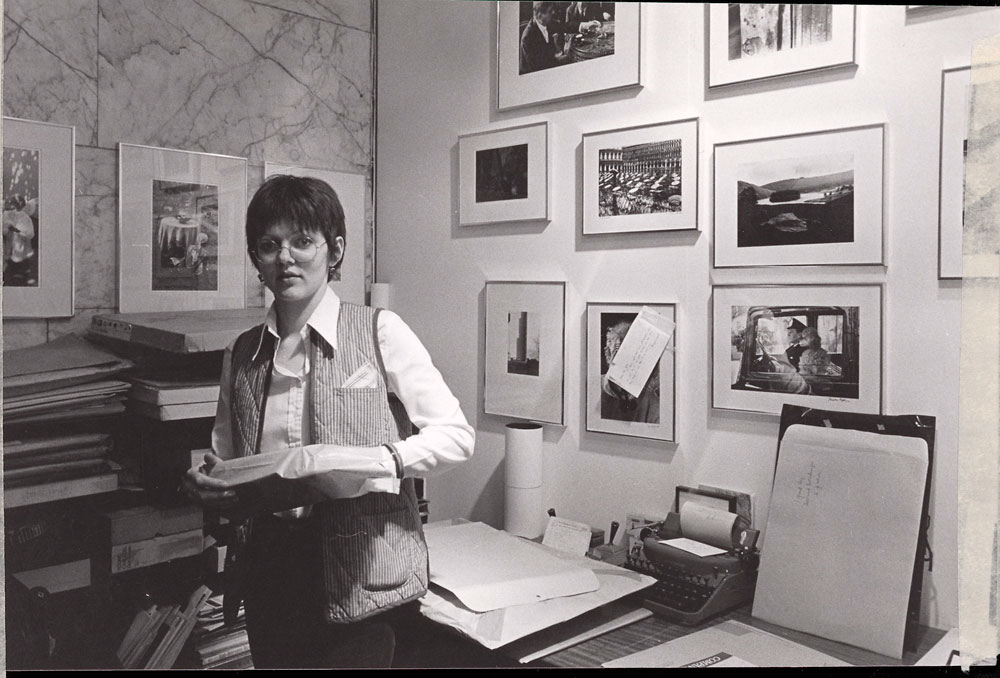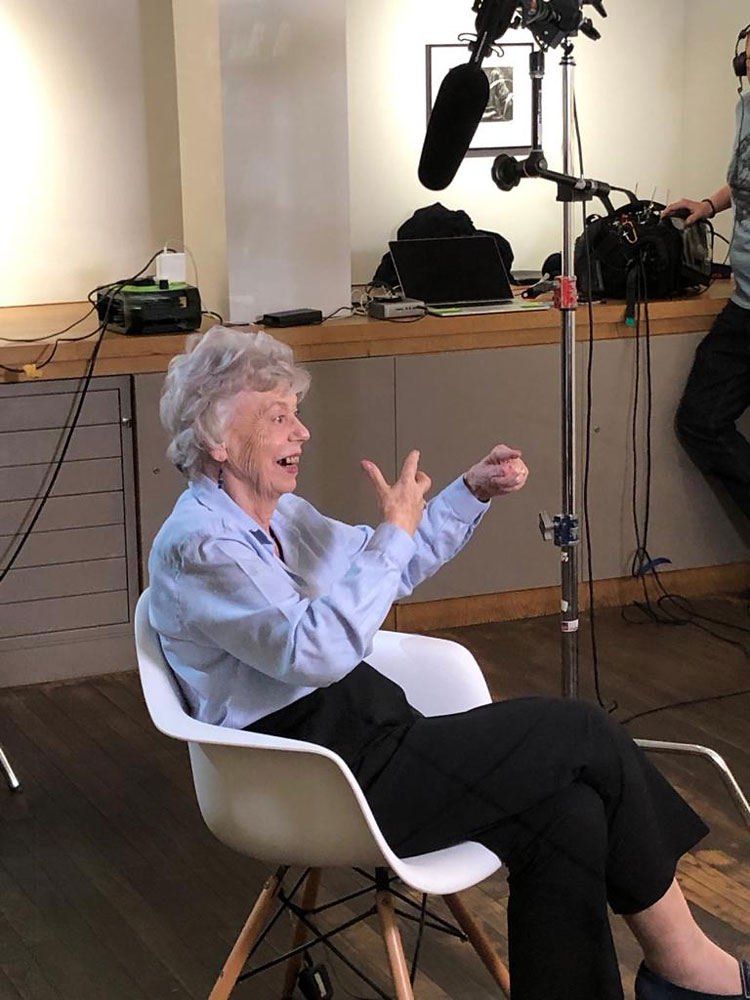Sue has gone and with her a part of my heart.
I want to share with you a few treasured memories, the atmosphere at The Photographers’ Gallery that Sue created and of London in the mid-1970s.
Much has been said about her life and her major contribution to photography, but little about her formidable persona – as boss, mentor, friend, wife and mother.
Two days after I arrived in London in March 1975 I started working at The Photographers’ Gallery. It was ten days before the photography auction that Philippe Garner and Sue had tirelessly worked on for months. It was held at Sotheby’s Belgravia to raise funds to repay the gallery loan which sales of books and a few prints could not cover… So, from the start I was thrown into a deep end. Mesmerised and oblivious of the true significance of the occasion, I quickly learned that the auction was indeed one of the most important events for photography in the UK. I still have the small catalogue – it would make you smile if you saw it – a thin 20-page white 20 x 21 cm catalogue, with 101 lots, mostly not illustrated, and the few that were reproduced, were in black and white.

That’s how it all started, my wonderful five years at TPG. Photography was not taught on an academic level at my University, in Zagreb. We didn’t have a Paul Hill, Thomas Joshua Cooper or David Hurn whose teaching in Nottingham and Cardiff complimented the best American photography historians of that time like Nancy and Beaumont Newhall, Bill Jay, Minor White, to name but a few. So, now in London, I was guided by Sue and her willingness to let her staff embrace any opportunity that came our way. Paul (Hill) had started his famous workshops in Derbyshire and Sue took me to a few on the history of photography and to meet Weston Naef at Lacock Abby. She was generous like that. If she recognised that you were keen and interested she generously gave her full support.
When we were in the Number 8 there wasn’t a small flat for her, like the one she had later the top floor in Number 5, so she commuted every night to her home in Barnham, Berkshire to husband John, daughters Jessica, Jo and Stephany, not forgetting the cat. At weekends, she would prepare meals for the family for the whole week – a great adventurous cook. Years later she was equally dedicated to her grandchildren.
What was most impressive about her was that she never stopped, she had an abundance of energy for work and a will of steel, selecting shows, talking to myriad people, visiting openings and photographic studios, theatres, attending business lunches/dinners. An avid reader, immensely intelligent and well informed about life in general, politics, cultural events, people – she was fun to be with.
Later in life when she was already seriously ill, when she could, she would go to exhibitions, the theatre, her beloved Arts Club in Chelsea to play Mah’jong and meet friends.
Whenever anybody in photography came to London they would come to see her: from Robert Mapplethorpe, Elliott Erwitt, a close family friend Bill Klein, to Cartier-Bresson (who we were asked not to recognize), to dealers/collectors like Harry Lunn, Sam Wagstaff, Stephen White, Lee Witkin, Madam Ileana Sonnanbend, museum curators like John Szarkowski, researchers/writers like Gail Buckland. The fashion queen Zandra Rhodes, Harry Evans, Bruce Bernard were regulars, Bill Brandt would often quietly sneak in to see Sue. He was represented by Marlborough Fine Art so he would come in as a friend, always very supportive of her…. The list of visitors was endless and everyone wanted to talk to her. She was a mine of information, constantly absorbing news, facts and gossip.
At the time TPG was the only photographic gallery in the UK, greatly dependent on the Arts Council of GB – Barry Lane, their officer, was wonderful, loved and knew a lot about photography, was always available and supportive.
Other galleries like the Half Moon in East London, Stills in Edinburgh, Impressions in York opened a few years later. The RPS was still in London, soon to move to Bath. The V&A was focusing more on showing photography as was The National Portrait Gallery. Robert Hershkowitz and Russ Anderson were busy expanding their business as were Ken and Jenny Jacobson. Colin Osman and Peter Turner were printing the Creative Camera, in black and white. Alan Porter produced the Swiss Camera with colour in it. Great publishing was coming from the States, and in the UK Gordon Fraser and Thames & Hudson were producing high quality photography books. Philippe Garner had established photographic auctions and major American dealers and collectors started to visit London regularly and would invariably visit Sue at TPG.
The photographic scene was changing rapidly and there was a buzz charged with good will and positive expectations.
Exhibition openings were always packed, to see the many masters who Sue had selected to exhibit, such as Manuel Alvarez Bravo, George Rodger, David Hurn, Brassai, Kertesz, Lartigue, Barry Latigan, Josef Sudek, Sam Haskins, Cornel Capa’s ICP touring shows, Magnum photographers who were then represented by John and Judy Hillelson, Imogen Cunningham, Edward Weston, Paul Strand, Franco Fontana, Bill Klein, Snowdon, August Sander (from Gert), June and Helmut Newton, Karl Blossfeldt, American museum touring shows, Young British Photographers, American, Australian, Canadian, French, German photography group shows, Arnold Newman, Mario Giacomelli, then there were the ‘young’ Mari Mahr, Martin Parr, Brian Griffin, John Davies to whom Sue gave their first major shows….. and the list goes on.
I believe that in the five years that I worked there many of the best in the world, the masters as well as the emerging young photographers, were shown at TPG. All chosen by Sue through her worldwide network and connections and the yearly in-house portfolio submissions.
In Europe she worked closely with her friend Agathe Gaillard. Viviane Esders had opened her lovely gallery behind Pompidou Centre and often came to London. Lanfranco Colombo from Il Diaframma in Milano lent works by well-known Italian photographers. Then there was Arles where Sue went most summers and would come back revitalised recounting what she had seen.
In 1976 Artefiera di Bologna included photography for the first time. Sue and I represented TPG. A number of American galleries came for the first time showing their amazing classics and contemporaries – a true feast. Lasting contacts and friends were made at the fair. And naturally, whenever in London they would come to visit Sue and TPG.
Sue enhanced these years because she was truly a wonderful boss, liberal, open-minded, generous, fair yet tough, a fighter and a survivor. Those memories stay with you.

And finally I want to share with you the story she sent me and which sums her up perfectly.
Her note said ‘Just a thought to brighten your day!’:
An elderly Chinese woman had two large pots, each hung on the ends of a pole which she carried across her neck. One of the pots had a crack in it while the other pot was perfect and always delivered a full portion of water. At the end of the long walk from the stream to the house, the cracked pot arrived only half full.
For a full two years this went on daily, with the woman bringing home only one and a half pots of water. Of course, the perfect pot was proud of its accomplishments. But the poor cracked pot was ashamed of its own imperfection, and miserable that it could only do half of what it had been made to do. After 2 years of what it perceived to be bitter failure, it spoke to the woman one day by the stream.
“I am ashamed of myself, because this crack in my side causes water to leak out all the way back to your house.”
The old woman smiled, “Did you notice that there are flowers on your side of the path, but not on the other pot’s side?” “That’s because I have always known about your flaw, so I planted flower seeds on your side of the path, and every day while we walk back, you water them.”
“For two years I have been able to pick these beautiful flowers to decorate the table.
Without you being just the way you are, there would not be this beauty to grace the house.”
Each of us has our own unique flaw. But it’s the cracks and flaws we each have that make our lives together so very interesting and rewarding. You’ve just got to take each person for what they are and look for the good in them.
SO, to all of my crackpot friends, have a great day and remember to smell the flowers on your side of the path!

